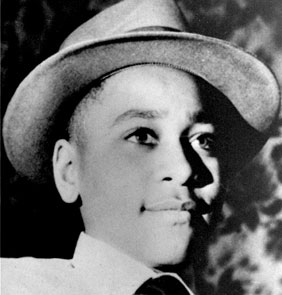Imagine sending your son to visit relatives, thinking you would see him again in a few weeks, only to learn two weeks later that he was murdered. Emmett Louis Till was born in Chicago, Illinois on July 25, 1941 to working class parents.1 His parents, both from the south, met in Argo, Illinois.2 Emmett sadly grew up without his father, after the Army executed him for raping two women and murdering a third in Italy. To add to this already hard life, Emmett got polio at a young age. Although he survived, he was left with a stutter. At school he was known as risk-taker, and he was also described as very outgoing. During the summer of 1955, Emmett’s mother sent him when he was only fourteen years old to Mississippi to visit some relatives, not knowing that she would never see her son alive again.3
Life in the south was much different than life was like where Emmett was from. He did not act the same way his cousins did around white storeowners. He talked freely about his girlfriend back home who was a white woman. One night, after a week in Mississippi, Emmett and seven other teenagers drove to a nearby town to hang out. While they were there, they went to the local grocery store owned by a white couple, Roy and Carolyn Bryant. Roy Bryant was away on a trip, and Carolyn was left in charge of the store. Several accounts exist of the events that happened next, but what is thought to have happened is the boys dared Emmett to go inside the store and ask Carolyn Bryant on a date. It is said that he went inside, bought a pack of gum, then grabbed her hand and asked her on a date. Immediately after this, she pulled away and ran into the back of the store to get a gun. During the time where she went into the back, Emmett’s cousins, realizing what had just happened, ran into the store and pulled Emmett out. As the teenagers were leaving, Emmett allegedly whistled at her and possibly even said, “bye baby!”4

After returning from his trip and finding out what had happened, Roy Bryant and his half-brother J.W. Milam went out to seek revenge. They arrived at the house of Moses Wright, Emmett’s uncle, late Saturday night, both armed with pistols. They stormed the house, ripped Emmett out from his bed, and drove off with him. His uncle pled with them, explaining Emmett was from the north and didn’t know any better, but the men refused to listen. They drove to Milam’s home where they tortured Emmett and mutilated his body. Then they took him to the Tallahatchie River where they forced him to take off all his clothes, shot him, then tied a metal fan to his body and rolled it into the river. Wright reported the kidnapping to the local sheriff the next morning, and by noon, police arrested the two men. They confessed to kidnapping him but claimed that they had let him go. Three days later, fishermen found Emmett’s body floating in the river.5
Mamie Till insisted on having Emmett’s body returned to Chicago so that she could have a funeral for him. She had an open-casket funeral so that everyone would see what had been done to her son. News of this spread immediately and caused an outbreak of protests. In Harlem, an estimated 20,000 people rallied to demand that Congress pass an anti-lynching bill.6
The trial of Roy Bryant and J.W. Milam began on September 19, 1955. Because African-Americans, and women were not allowed to serve as jurors in Mississippi, the jury was all white and all male. After four days of testimony, the jury acquitted Bryant and Milam of all charges. The two later confessed to the murder in an interview, but because of double jeopardy they were not able to be prosecuted.7
Following the news of the trial, thousands of outraged people spoke out. People began to realize that even after Brown v. Board of Education, there was still so much more that needed to be done. Citizens sent letters to their congressmen and the White House, newspapers editorials bashed the jury’s decision, and the number of people in the NAACP expanded greatly. Mamie Till spoke out on multiple occasions about the injustice that her son received. She told people to remember what happened to him and to continue fighting for justice. In addition, popular artists at the time including Gwendolyn Brooks, Toni Morrison, James Baldwin, and Bob Dylan used their own talents to create works dedicated to the Emmett and his case.8
In 2004, the FBI reopened the case. This investigation lasted three years, and during it they exhumed Till’s body to do a complete autopsy. The autopsy did not lead to any criminal charges, but it did lead to Milam’s brother confessing on his deathbed about his own involvement in the kidnapping. Till’s body was put in a new casket and his old casket was later donated to the Smithsonian’s National Museum of African American History and Culture.9
In 2008, a bill was signed into law called the Emmett Till Unsolved Civil Rights Crime Act, which provided funding to “reinvestigate crimes against civil rights workers and their allies.”10 Till’s name continues to remain in our nation’s memory, specifically through the statue of him and Dr. Martin Luther King, Jr. in Denver’s City Park, and in the Emmett Till Players that his mother formed in Chicago. Even today, his case is still being looked at. It was reopened in 2018 due to the publication of a book containing a confession from Carolyn Bryant that states she lied in her testimony during the trial.11 Even though the men who did this to Emmett Till got away with it, the nation is still fighting to get him the justice he deserves. No matter how long ago something occurred, it is never too late to seek justice.
- Encyclopedia Britannica, 2018, s.v. “Emmett Till,” by Michael Ray. ↵
- Simeon Wright and Herb Boyd, Simeon’s Story: An Eyewitness Account of the Kidnapping of Emmett Till (Chicago: Chicago Review Press, 2010), 14. ↵
- James J. Podesta, “Till, Emmett 1941-1955,” Contemporary Black Biography 7 (1994): 262-266. ↵
- James J. Podesta, “Till, Emmett 1941-1955,” Contemporary Black Biography 7 (1994): 262-266. ↵
- James J. Podesta, “Till, Emmett 1941-1955,” Contemporary Black Biography 7 (1994): 262-266. ↵
- James J. Podesta, “Till, Emmett 1941-1955,” Contemporary Black Biography 7 (1994): 262-266. ↵
- Encyclopedia Britannica, 2018, s.v. “Emmett Till,” by Michael Ray. ↵
- Salem Press Biological Encyclopedia, 2014, s.v. “Emmett Till,” by Catherine R Squires. ↵
- Encyclopedia Britannica, 2018, s.v. “Emmett Till,” by Michael Ray. ↵
- Salem Press Biological Encyclopedia, 2014, s.v. “Emmett Till,” by Catherine R Squires. ↵
- Salem Press Biological Encyclopedia, 2014, s.v. “Emmett Till,” by Catherine R Squires. ↵



49 comments
Nathalie Herrera
I had never heard the story of Emmett Till before. Yet, this story was a sad and gruesome one. Emmett had not only had a rough start in life with his father being out of this picture and getting polio at such a young age resulting in a stutter, but his death is truly tragic. A mindless dare conducted resulted to his deathbed. It is a shame these horrific actions took place because of a dare but mainly because of the judgment of his skin color. Although, this was a good and interesting read!
Rylie Kieny
This is a very sad story that needs to continue to be heard. It is a very sad and tragic situation but one that led to many rallies and other civil right movements. Although I’m sure it was very hard for his mother to hold an open casket viewing I think it was very brave and important to his story. It allowed for many to see the reality of being African American in a racist society. It is very unfair that the men who committed such heinous crimes will see no justice but I hope this case changed views of many around the country. I like how you gave good detail the whole way through the story. It made it very interesting and very understandable.
Enrique Segovia
I liked the introduction to the article, since it established the point to be discussed, and it exposes immediately that Till was murdered. Also, I liked the second picture because it is somehow an important place in Till’s life, because he asked Carolyn out on a date in that market. Remarkably, Till got justice too late, although his case marked history. It was not until 2004 that the FBI opened a new investigation by performing an autopsy, but no charges were pressed. Anyhow, the autopsy caused someone to confess about one of the things that happened to Till, making Till have justice.
Martina Rodriguez
While I had heard Emmett Till, I had no idea about the beginnings of his story (ie his childhood). Sad to think that the events that would lead to his death all started over a foolish prank. I’m surprised that his mother requested to have an open casket funeral. How frustrating that because of double jeopardy the two men could not get the justice that they deserved.
Christopher Hohman
Nice article. It is such a terrible thing what those people did to Emit Till. I cannot believe that human beings would behave in such a way. It is terrible that those men were not tried for their terrible crime. They had no right to do what they did. Not to Emit not to anyone. I just cannot understand how you can judge a person based on the color of their skin instead of the character of their heart. Rest In Peace Emit
Cooper Dubrule
I had read about Emmett Till in a previous class so I knew the basic information about the situation however this article took it to a knew level and brought me to an even better understanding of what exactly happened. I had never known that the two later confessed publicly to the murder and I think that illustrates just how broken the justice system was back in those times.
Robert Freise
The murder of Emmett Till is terrible and He and his family deserved justice. How can you torture and murder somebody and not go to prison for that? The south during this time was very unforgiving for African Americans during this time. The combination of ignorance and pride manifested within the south and in these mens mind. I don’t understand that a simple asking out can turn into a down right murder. This article informed me about the injustices in the south during this time and the sadness of the life of Emmett Till.
Eric Ortega Rodriguez
This is a very sad story and one I have never heard before in any of my history classes. What Roy Bryant and J.W. Milam did to Emmett Till seems so cruel it almost seems unreal. It is sad to realize that the actions made by Emmett Till made toward Carolyn Bryant might have just been a joke but it had terrible consequences. I agree with the author in the sense that justice was not served to Emmett Till and that it is never too late to seek out justice.
Maxx Arizmendi
The murder of Emmett Till is so sad. It’s outrageous to think that at first, he didn’t get the justice that he deserved, mainly because the jury consisted of all white males. I think this article did a great job on telling the story of Emmett Till, and how the author went into detail as to how he was murdered. This article was a great read.